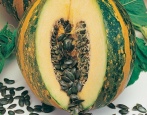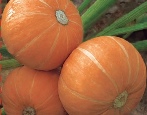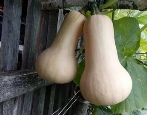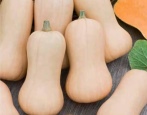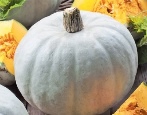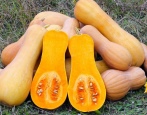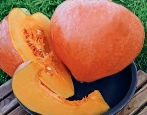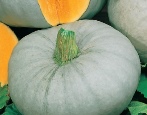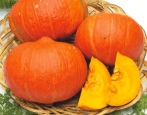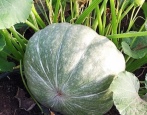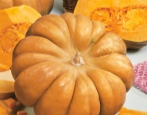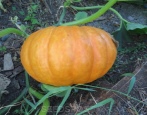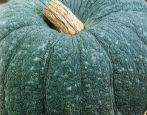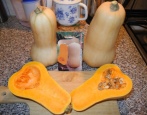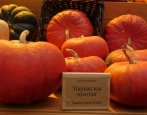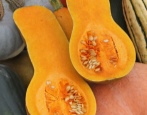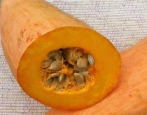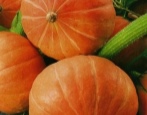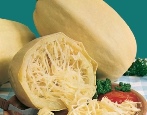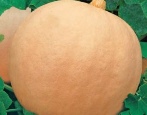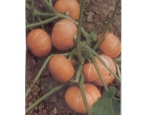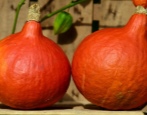
- Authors: Jiri Horal, Klapste Petr, Alekseev Yu.B., Mohelska Jana
- Year of approval: 1998
- Growth type: powerful
- Leaf color: green
- The form: oval-rounded
- Weight, kg: 6.5-9.7 (according to the originator, reaches 70)
- Coloration: orange, no pattern
- Bark: thick, leathery, cut orange
- Color of the pulp: yellow-orange
- Pulp thickness, cm: 6-8
You can grow a tasty and healthy pumpkin in a country house or garden ridge if you choose a non-capricious variety that quickly adapts to growing conditions. For regions with a warm and humid climate, a medium-late variety called Atlant of Czech selection will become productive.
Breeding history
Pumpkin Atlant is a delicious variety bred by a group of scientists from agricultural firms Moravoseed and Semko in 1995. The authorship belongs to the breeders Alekseev Yu.B., Jiri Horal, Klapste Petr, Mohelska Jana. The vegetable crop appeared in the State Register of varieties approved for use in the territory of the Russian Federation in 1998. It is recommended to grow a vegetable in the North Caucasus region, where the climate is quite warm and comfortable.
Description of the variety
Pumpkin Atlant is a powerful climbing plant with large and dark green leaves of a round shape with pointed ends, thickened stems with a pronounced edge, long lashes, as well as a fragile root system. During the flowering period, large bright yellow five-lobed flowers appear on the bushes, emitting a pleasant aroma. Usually 2 pumpkin specimens are formed on each plant.
Characteristics of the appearance of plants and fruits
The variety represents a class of large-fruited varieties. Pumpkins grow quite large - 6.5-10 kg, but there are specimens that are much larger. The shape of the vegetable is oval-rounded, and the surface is slightly segmented or absolutely smooth. If you look closely, the pumpkin is vertically divided into equal shares. The pumpkin bark is dense, tough, yellow-orange in color, without a clear pattern. The seed nest is medium in size and contains a small amount of large cream-colored elliptical seeds.
The harvested pumpkins, thanks to their strong crust, easily carry transportation over any distance, and also have a good keeping quality: from several months to a year. In order for vegetables to be stored for a long time, it is necessary to cut them off along with the stalk.
Purpose and taste
Pumpkin Atlant is characterized by excellent taste. The yellow-orange pulp is endowed with a dense, slightly oily, tender, fleshy and juicy consistency without fiber. The taste of the vegetable is balanced: pronounced sweetness and pleasant sugariness are perfectly combined with a rich fragrant pumpkin aroma. The vegetable pulp contains useful components: vitamins of group B, A, E, C, as well as magnesium, potassium, phosphorus, iron, zinc. In addition, pumpkin contains about 15% sugars and 20% starch.
Cut pumpkins are widely used in cooking: they are used to prepare cereals, casseroles, mashed potatoes, preserves, juices, and are used as a filling for baking. This pumpkin variety is often ideal for baby and diet food.
Ripening terms
Atlant is a medium late variety. From the appearance of the first sprouts to ripe vegetables on the ridges, 112-136 days pass. The fruits ripen gradually, so they are cut off as they ripen. Dry stalk and uniform color of the bark indicate absolute ripeness. You can cut pumpkins in the garden from late August to early September.
Yield
High productivity is one of the advantages of this variety. With industrial cultivation, you can count on a good yield - 150-212 centners / ha of plantings. The maximum indicator was recorded at around 280 c / ha of plantings.
Growing and care
You can grow pumpkin in seedling and seedless ways. When planting through seedlings, it is necessary to prepare a nutritious substrate, peat cups and high-quality seeds. Sowing is carried out from the end of April, and the bushes are transferred to the garden a month later - at the end of May. Several seeds are planted in each container, deepening by 3-5 cm. The first 10 days provide a greenhouse effect, which will accelerate the emergence of seedlings. Transplanting to the garden bed is carried out according to the scheme 90x150 cm, since the bushes will then drag along.
Sowing seeds in open ground is usually carried out in the southern regions. For planting, a time is selected when the soil and air are well warmed up. As a rule, this is the end of May or the beginning of June. Fertilizers are applied to the holes, a few seeds are laid, and then the planting is abundantly moistened with warm water. The best precursors for pumpkin are cereals and root vegetables.
Caring for a vegetable crop consists of standard procedures: weekly watering (irrigation stops after the formation of fruits), thinning of bushes, formation (pinching of the side lashes and the central stem), weeding and loosening of the soil, fertilizing 2-3 times per season (pumpkin reacts well to mineral complexes), light mulching, prevention of fungal infections.
Requirements for soil and climatic conditions
The culture is not afraid of cold snaps, drought, short-term shade. Despite this, pumpkin should be grown in a sunny area, where it is light and warm. It is comfortable for a vegetable to grow in light, fertile, drainage and non-acidic soils. It can be light and nutritious sandstone or loam.
Disease and pest resistance
Strong immunity provides the culture with resistance to many diseases: various rot, powdery mildew, bacteriosis.
